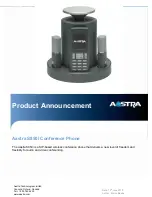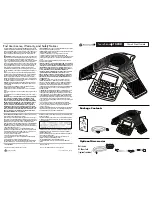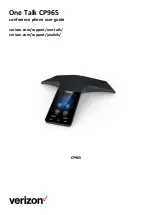
82
Emergency Calls / SOS
Radio Frequency (RF) Signals
Your mobile phone is a radio transmitter and receiver. It is designed and
manufactured not to exceed the emission limits for exposure to radio
frequency (RF) energy set by the Federal Communications Commission of
the U.S. Government. These limits are part of comprehensive guidelines
and establish permitted levels of RF energy for the general population.
Those guidelines are consistent with the safety standard previously set by
both U.S. and international standards bodies:
●
American National Standards Institute (ANSI) IEEE. C95.1–1992
●
National Council on Radiation Protection and Measurement (NCRP).
Report 86
●
International Commission on Non-Ionizing Radiation Protection (ICNIRP)
1996
●
Ministry of Health (Canada), Safety Code 6.
The exposure standard for wireless mobile phones employs a unit of
measurement known as the Specific Absorption Rate, or SAR. The SAR
limit set by the FCC is 1.6W/kg. Tests or SAR are conducted using standard
operating positions specified by the FCC with the phone transmitting at its
highest certified power level in all tested frequency bands. Although the SAR
is determined at the highest certified power level, the actual SAR level of the
phone while operation can be well below the maximum value. This is
because the phone is designed to operate at multiple power levels so as to
use only the power required to reach the network. In general, the closer you
are to a wireless base station antenna, the lower the power output.
Before a phone model is available for sale to the public, it must be tested
and certified to the FCC that it does not exceed the limit established by the
government-adopted requirement for safe exposure. The tests are performed
in positions and locations (e.g., at the ear and worn on the body) as required
by the FCC for each model. (Body-worn measurements differ among phone
models, depending upon available accessories and FCC requirements).
While there may be differences between the SAR levels of various phones
and at various positions, they all meet the government requirement.
83
Emergency Calls
Important!
This phone, like any mobile phone, operates using radio signals, wireless
and landline networks as well as user-programmed functions which cannot
guarantee connection in all conditions. Therefore, you should never rely
solely upon any wireless phone for essential communications (for example,
medical emergencies).
Remember, to make or receive any calls the phone must be switched on and
in a service area with adequate signal strength. Emergency calls may not be
possible on all wireless phone networks or when certain network services
and/or phone features are in use. Check with local service providers.
To make an emergency call:
●
Switch it on.
●
Key in the emergency number for your present location (for example, 911
or other official emergency number). Emergency numbers vary by location.
●
Press the key.
To make SOS call:
●
Switch it on.
●
When your phone is locked, press the key.
If certain features are in use (key guard, restrict calls, etc.), you may first
need to turn those features off before you can make an emergency call.
Consult this document and your local cellular service provider.
When making an emergency call, remember to give all the necessary
information as accurately as possible. Remember that your phone may be
the only means of communication at the scene of an accident – do not cut off
the call until given permission to do so.
Emergency Calls
S500E UserMan/ENG 9/15/04 3:44 PM Page 82





































